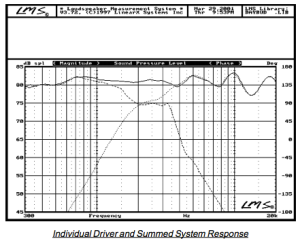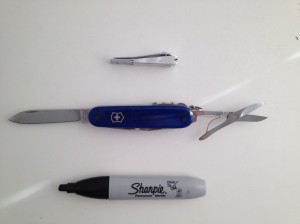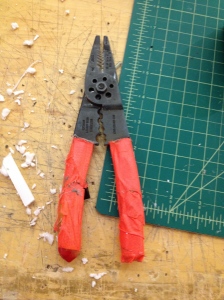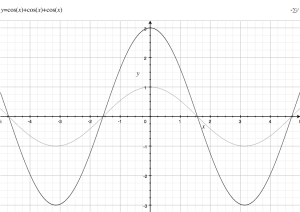I made this with my friend Takumi Ogata last spring. Unfortunately, I couldn’t find any pictures of him playing bass.
e-bow action
A port tube can extend the low-end response of a speaker beyond the lowest frequencies that can be produced by the woofer at an adequate volume. However, one of the drawbacks is that it takes time for the port tube resonance to die out. The best way to represent this is with a waterfall plot.
This shows the amplitude of all the frequencies decaying in time. The longest resonance is near the same frequency as the port tube. And when we plug the port tube with a towel…
…. We can see that the resonance of the tube dies much more quickly.
Subjectively, I want to hear more bass when I listen to the BR-1s, my speaker amplifier has a basic EQ, and the speakers sound more “flat” to me when I turn up the bass on the amp.
I find it interesting that what sounds “flat,” and subjectively pleasing to me is actually far from an ideal flat response.
In order to better understand that data from the previous measurements, I also took some measurements at my apartment.
PORT NOT PLUGGED
PORT PLUGGED
The graphs above show how the minimum value of the amplitude axis can greatly affect how the graph is interpreted. I tried to have the minimum value of the amplitude axis just slightly above the noise floor, which was at about -40dB.
I also took measurements at my apartment with my Presonus M7 condenser microphone.
The Dayton Audio measurement microphone was clearly a good choice as the Presonus microphone leaves out a lot of the bass information.
It is difficult to measure the frequency response of speakers because microphones do not have a flat frequency response, and the resonate frequencies of a room make some frequencies louder than others. However, if we keep these variables consistent, we can learn about the performance of a pair of speakers by comparing them with other monitors using the same room and the same microphone.
The image above shows the frequency response of my BR-1and a Meyer Sound speaker which I believe was an HD 1. These measurements were made with the program Fuzz Measure, the Dayton Audio EMM 6 microphone, and my Presonus Audiobox audio interface.
The most noticeable difference between the two speakers is the peak between 10kHz and 20kHz in the BR-1s and the deep trough between 60 and 70 Hz.
Here are the frequency response graphs for the individual drivers given in the manual.
The stark differences suggest that my measurements were greatly influenced by the room modes. To try to compensate for this, I took measurements from many different locations around the room and averaged them.
The effects are noticeably reduced, and with a high enough sample size, could become negligible. However, it should also be noted that the resonant frequency of the port tube is 43 Hz– one of the peaks both graphs.
I decided to try to do some of my own measurements on the BR-1 kit I build so I headed out to the lab.
I sent a sinusoidal signal from the function generator to both the oscilloscope and to my speaker.
I then measured the voltage over the woofer, and then over the tweeter while changing the frequency of the input.
I recorded the data from the oscilloscope.
Using Excel and Matlab, I plotted the ratio of the input peak-to-peak voltage to the output peak-to-peak voltage.
Here is the figure given in the BR-1 manual for the frequency response of the individual drivers and the summed system response.

The graph above was made with a microphone placed 45″ from the tweeter of the speaker. The acoustic crossover frequency occurs at 2.1kHz. My measurements show the crossover frequency to be closer to 3kHz, however, there are a few reasons to believe my measurements have some error. The impedance of the driver depends on the amount of force required to move the speaker cone, and the amount of force required to move the speaker cone is probably different when the driver is mounted to an airtight cabinet. In order to get access to the driver and crossover circuit, I had to partially remove the woofer and tweeter from the cabinet. I believe that this caused significant error in my measurements. Still, it was satisfying to demonstrate the general contour of the crossover circuit on my own.
In the past few posts, I’ve been throwing a lot of words and equations at you, but I haven’t actually demonstrated that anything I’ve said is true. So here I’m going to demonstrate a few of the comb filtering concepts.
In my first comb filtering blog post I said:
“Therefore: f = (180°(2n+1)) / (360°*Δ) Now just plug in your delay time and values of n to find out which frequencies are canceled.
Let’s say your copied signal is delayed by .0005 seconds (aka half a millisecond). When n = 0,1,2,3,4,… f = 1000,3000,5000,7000,… respectively.”
I want to show you that this really happens. In order to create this effect, I used an audio file (Little Lies by Fleetwood Mac) and a sample delay in my DAW, Logic 9. The track is sampled at 441000 samples per second, so if we want to find how many samples we need to delay to be equivalent to half a millisecond we observe:
(seconds/samples) * samples = seconds
1/44100 * samples = .0005
samples = .0005*44100 = 22 (approximately)
The effects are actually pretty apparent just by using the spectrum analyzer in Logic’s Channel EQ
No Comb Filter:
Comb Filter:
You can see that the frequencies that we predicted would be notched, 1000, 3000, 5000, 7000,… are indeed the frequencies that are notched. This difference between the two is clearly audible and I encourage you to try this on your own, as I am hesitant to upload copyrighted material.
From the first post, we know if we take two identical signals, delay one, and then sum the them, there will be frequency cancellation known as comb filtering. As abstract as that sounds, it actually happens in physical environments. If one of your speakers is farther from your ear than the other, two identical signals, one delayed, will reach your ears (the identical signals will be whatever is coming from the center of the stereo image, not the left and right). Another example might be the direct sound from the speakers, and the first reflection off of a desk or wall. Lastly, if you are recording an instrument using multiple microphones, an identical signal could reach the microphones at different times if they are spaced unevenly from the source.
What kinds of distances should we be concerned about? A foot? An inch? Here’s I’ll derive a formula for how distance corresponds to delay and frequency cancellation.
In the previous post, we found which frequencies are cancelled as a function of the delay:
f = [(2n+1)*180°] / [Δ*360°] where Δ is the time delay in seconds
We want to relate distance to delay. The units of speed of sound are feet/ second, so if we multiply (feet/second) by seconds, we get feet, the unit of distance. We also have a handy formula above that relates seconds to frequency. So here’s the math:
v * Δ = d (v feet per second, Δ seconds, d feet)
Δ = [(2n+1)*180°] / [f*360°] (f hertz — from the formula above)
v * [(2n+1)*180°] / [f*360°] = d (by substituting in Δ)
f = [(2n+1)*180°*v] / [d*360°] (frequency cancelled as a function of velocity and distance)
Because we solved out math problem in variables, we can choose the system of units we prefer. Because I’m from the United States, and most of the people who read this will probably be from the U.S., I’m going to use feet/inches.
v = 1100 ft/sec
Frequencies Cancelled:
From the table, we can see that 1 inch is relatively harmless because the frequencies cancelled very quickly go beyond the range of human hearing. If we are setting up our microphones or speakers, we probably don’t need to worry about distances much smaller than an inch. This suggests that, rather than be concerned with minute delays from direct sound, we should be more concerned with reflections. Reflections will be the topic of the next post.
This post is not meant to give you detailed instructions on the BR-1 assembly. The professionals have already done that here: https://www.youtube.com/watch?v=t_e1Ex8yJ6g and here: https://www.youtube.com/watch?v=c-N_vx6oOVE.
However, my experience of building the kit was not quite as simple as they’ll have you think from watching those tutorial videos. This post will be a good supplement to anyone who is building the kit. It has some work arounds for when you don’t have all the right tools, and some tricks I found useful along the way.
TOOLS

 You’ll also seed a hot glue gun and a crimp tool.
You’ll also seed a hot glue gun and a crimp tool.
CROSSOVER
I arrange my components like this to ensure that I don’t make a mistake. You’ll also notice my special high quality wire cutting tool: fingernail clippers. If you don’t have wire cutters that can make a cut that is flush with your solder joint, fingernail clippers are a great work around. It’s important to clip the wires flush with the joint in order to glue the crossover to the cabinet later.
WIRES
Mark your cable before you cut so you don’t make any mistakes. I also took a sharpie and marked one side of each cable black for negative, so that I don’t make polarity mistakes later when the crossover circuit is difficult to see.
ACOUSTIC FOAM INTERIOR
When you’re cutting your foam, proportions are more important than exact inches because the piece of foam they give you often isn’t exactly the right size. Maybe according to the manual, 9″ from one side is half way, but after you cut, you might find that your other piece is only 7 1/2″ wide. Darn. So find the halfway point for your particular piece of foam. I found that angling my knife away from the direction I was cutting made the cleanest edges.
PUTTING IT ALL TOGETHER
Here you can see that marking the cables was a really good idea as the crossover circuit gets completely covered with foam. I also marked the back of the cabinet for polarity. The polarity is marked on the terminal block, but it is hard to see on the black plastic. I also found that I didn’t need to use all of the foam they gave me to completely cover the interior of the cabinet, and once I got all the foam in there, it was held in place by friction and tension from all the other pieces of foam. I didn’t feel the need glue the foam into place. I’m only a bit worried about the top piece. I’ll probably go back and glue that one at a later time.
Comb filtering is a type of “interference.” Interference can be parsed into two categories: constructive and destructive.


In the graphs above, the bold line is the sum of mathematical signals. You might be wondering where the bold line is in the second graph. In the second graph, the sum of the two signals was destructive, and the amplitude of the signal was reduced to zero. In the first graph, the sum of the signals was constructive, and the amplitude increased by a factor of 3. The featured image at the top of this post shows the two individual signals that were summed to make the second graph. When one is up, the other is down, and always by the same amount. Imagine that the bold line is a copy of the lighter line that we dragged to the left. We can describe this mathematically by saying the signals are 180° out of phase. But imagine that we kept dragging the bold line farther and farther to the left. The two lines would eventually line up with each other (now you’ve shifted the signal 360°). If we kept going, they would become out of phase again (now you’ve shifted the signal 540°). When a copy of a signal is shifted by an odd number multiple of 180° and summed with the original signal, the signals will cancel with each other. This is the basis of comb filtering.
Until now we’ve been talking about shifting signals in terms of degrees. Now we are going to talk about shifting signals in time. Delaying a signal by 180° is equivalent to delaying it by half of the signal’s period. Let’s imagine that we’re listening to a piece of music on a pair of speakers. The spectrum of human hearing ranges from 20Hz to 20,000Hz. Now we move one speaker so that it is one foot farther from our ears than the other speaker. We have now delayed one signal. Given that each speaker is likely producing frequencies from around 40Hz to 18,000Hz, it is likely that the delay we created is half of the period of some frequency, and is therefore being canceled. It is also likely that other frequency’s half periods are odd numbered multiples of the delay, and will be canceled as well. Can you guess which ones? I can’t! So I derived a mathematical formula for it.
First, we need an expression for an odd number multiple. Any number multiplied by 2 is even. Any even number plus 1 is odd. So (2n+1), (where n is a whole number greater than or equal to 0; n = 0, 1, 2, 3, …) is an expression for odd number multiples. We are interested in situations where a signal is delayed by half of the frequency’s period. So here’s the math.
Delay = Δ seconds; Period = T seconds; Frequency = f Hz (Δ is the capital greek letter “Delta.”)
Δ/T = (180°(2n+1)) / 360° –This is a ratio that says our delay divided by our period is the same as an odd number multiple of 180° divided by 360°.
*******You might wonder why I don’t say Δ/T = (1/2)(2n+1). After all, that expression means that the delay is half of the period and is much simpler. I’m using the degrees to relate it to what we learned about interference before.********
You might know that T = 1 / f.
So f*Δ=(180°(2n+1)) / 360°
HERE’S THE FORMULA
Therefore: f = (180°(2n+1)) / (360°*Δ) Now just plug in your delay time and values of n to find out which frequencies are canceled.
Let’s say your copied signal is delayed by .0005 seconds (aka half a millisecond). When n = 0,1,2,3,4,… f = 1000,3000,5000,7000,… respectively.
Ouch. Those are all frequencies you’d want to be hearing when you’re mixing audio. Comb filtering is something we should be concerned about.
Now we know how time delay corresponds to frequency cancellation. But how does time delay happen in listening environments? One obvious place is the difference in distance from your speakers to your ears, but a more subtle case is reflections from walls. This will be the subject of the next post.
Hi! My name is Brian Kelley. Welcome to my blog!
This blog is where I will chronicle my adventures into the world of DIY audio. I have two main goals for the blog. I want this blog to be interesting to readers who already have a working knowledge of the subjects I will discuss. I will do this by including math and physics that could be interesting to readers with less formal backgrounds. However, I don’t want to write at a level that will exclude beginners. Although this is a blog about sound, I am passionate about the idea that language should never exclude anyone. I will try to use jargon minimally, and I will try to write as clearly and simply as possible- as I believe all writers should.
I’m currently assembling a pair of speakers that I’ll use for mixing. Later, I’ll work on positioning the speakers in my room, and acoustically treating the room. I’ll document that process in future posts, and I’ll also be publishing short articles on the physics that govern the decisions I make.
Stay tuned,
Brian